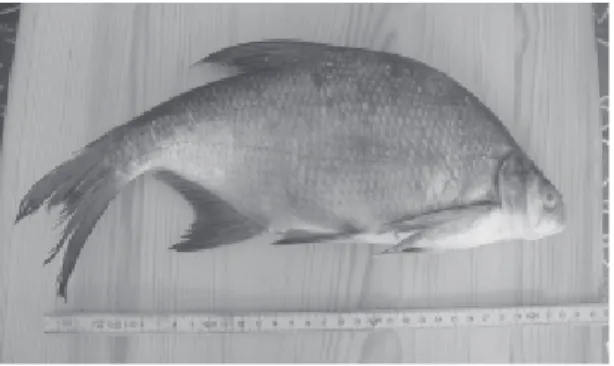Mongolian Journal of Biological Sciences 2004 Vol. 2(1): 69-70
69
Fig. 1. Picture by Zakhvatkin A. (Berg et al., 1949) Fig. 2. The specimen from Orhon river.Photo by S.Battulga
New Discovery of Bream Fish (
Abramis brama orientalis
Berg, 1949) in the
Orhon River, Northern Mongolia
Nyamsuren Batsaikhan
1, Sumiya Battulga
21Department of Zoology, Faculty of Biology, National University of Mongolia, Ulaanbaatar 210646, Mongolia 2IV secondary school, Darhan, Mongolia
This bream species was discovered on 1st May, 2004 for the first time in the Orhon and Eroo river delta (N 490 57', E 1060 07'). Originally,
autochthonous freshwater species in the Ponto-Caspian faunistic complex and the subspecies inhabits the basins of the Caspian and Aral Seas (Sidorova, 1980). Abramis brama orientalis
inhabits the lower reaches of the Volga and Ural rivers, North Caspian, Kyzlyar Bay and distributed the Kura river basin from Mingechaur reservoir to all addtional water bodies. This subspecies inhabits three types of water bodies during its life span in rivers, delta - front of the Volga river and shallow areas of the Caspian Sea (Sidorova, 1980). It has a benthic life feeding on invertebrates, particularly chironomids, small crustaceans, mollusks and water plants (Belova and Polyaninova, 1985). This bream is a semi-anadromous fish, characteristic migrations are spawning, feeding and wintering (Sidorova, 1980).
The genus is characterised by a strongly compressed from lateral side and deep body, a scaleless keel between the vent and pelvic fins, dorsal fin short and spineless, anal fin long to very long and lateral line decurved (Fig. 1). The mouth is small but protrusible. Dorsal fin with 3 unbranched and 8-10, usually 9, branched rays, anal fin with 3 unbranched and 22-30 branched rays.
Lateral line scales 48-60. Gill rakers number 22-30 and are short, reaching the raker below when appressed (Berg, 1949). Pharyngeal tooth formula modally 5-5, with variants of 6-5, 5-4 and for collections from the Caspian and Aral seas basins in former Soviet Union. According to Sidorova (1980) the morphological measurements of the subspecies from the Caspian sea are as follows: antedorsal length is 56.3% of body length, postdorsal length is 35.5% of body length, maximum body depth is 35.8 and minimum 9.8. Snout length 6.5, eye diameter 4.8 and head length 21.6.
Meristics in the Mongolian specimen: dorsal fin with 3 unbranched and 9 branched rays, anal fin with 3 unbranched and 26 branched rays. Lateral line scales 54. Gill rakers number 24. Antedorsal length 48.7% of body length, postdorsal length 29.3% of body length. Maximum body depth 31.1, minimum 8.6. Snout length 5.36, eye diameter 3.5, head length 19.8.
According to our measurements, this fish is smaller than the Caspian population (Fig. 2). We think that it is accordingly for one specimen measurement, but those meristic values are related to the Caspian subspecies. In 1954 this fish was introduced in the Baikal Lake basins at Ubinsk and Buriat lakes and Kama river (Neronov et al., 2003).
[Notes from the field]
N. Batsaikhan&S. Battulga
70
Our finding of the fish is evidence for its naturalization in the Orhon-Selenge river basins of Mongolia.
We are grateful to Mr. J. Bayarsaikhan from Darhan city for helping to catch the fish.
References
Belova, L.N. and Polyaninova, A.A.1985. Food relations between benthic feeding fish in the Northern Caspian. In: Caspian Sea. Fauna and biological productivity. Nauka Press. Moscow. Pp.248-256 (in Russian)
Berg, L.S. 1949. Freshwater fish of the USSR and adjoining states. USSR AS. Vol.2. Moscow-Leningrad. Pp. 774-780 (in Russian)
Berg, L.S. Bogdanov A.S. and Kojin, N.I.1949. Commercial fishes of USSR. Atlas of fishes. USSR AS. P. 152
Neronov, Yu. V., Pronin N.M. and Sokolov, A.V. 2003, Fish and fishery of Buryatia, Russian Federation. Ulan-Ude, Publishing of Buryat Science Center of SD RAS.(in Russian), Sidorova, M.A. 1980. Distribution of Bream
